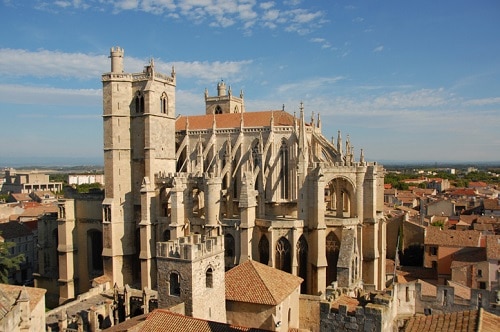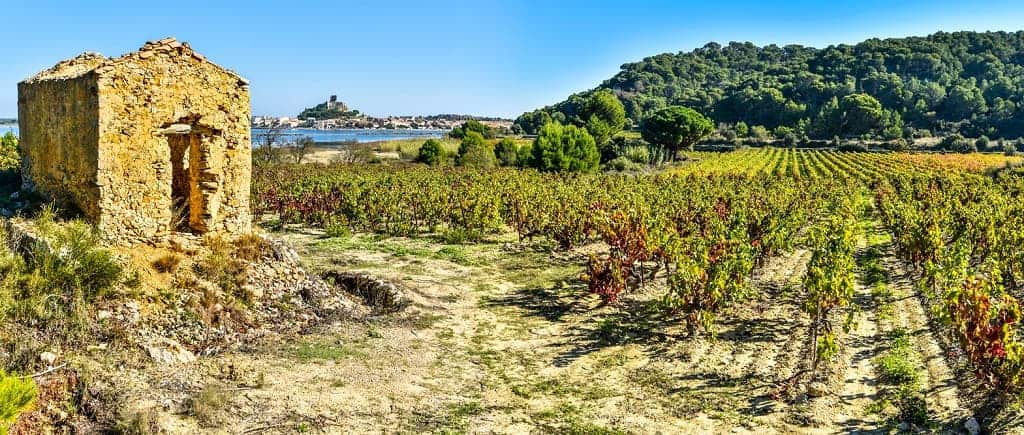Winetraveler is back in Languedoc, France, a region in the South of France, for the second of three regional itineraries. We previously offered an option covering the northern wine routes of Languedoc from Montpellier to Pézanas. For this itinerary, we’re adding more adventure to the route as we explore a few coastal wineries, villages and a national park near Narbonne.
How to Get to Coastal Languedoc
If you’re picking up this itinerary from the Montpellier route, you’ll simply drive or train south along the coast from Pézanas to Narbonne, France. Alternatively, if you’re beginning with this itinerary, and flying in from the States, there are numerous flights to Paris daily and from there, it’s a quick flight or train to Narbonne. We recommend renting a car for this active itinerary or hiring a driver for various excursions.

Days One to Three
Where to Stay – Narbonne, France
Tucked away on the the island of Gua, on the right bank of the Robine Canal (a UNESCO World Heritage Site in Narbonne), Ile du Gua Suites sits between the canal lock and a municipal garden. It’s a beautifully appointed oasis in this Languedoc town with suites offering kitchens, jacuzzi spas and private wooden terraces with canal views.
Recommended Restaurants
One of the best ways to experience a city’s culture and cuisine is to visit the local food market. Les Halles de Narbonne offers the opportunity to visit 66 vendors from butchers, bakers and wine merchants, to spices, candies and coffee. It’s a sensory treat to explore the hall and we recommend stopping in for breakfast early in the day. Watch the stands come to life, blend in with the locals as they come in to shop for the day’s meal, or sit and practice your French with a shop owner over a latte.
Winetraveler Tip: We recommend ordering a selection of fresh local oysters, cheeses and crusty bread to pair with a local white wine – and yes, for breakfast!
A 20-minute walk or short drive from Ile du Gua Suites, and near Les Halles de Narbonne, this seasonally inspired restaurant dishes up fresh, local products and has an on-site sommelier to help pair local wines with your selections. Dine indoors or out, but plan to linger in this relaxing, gourmet setting.
Wineries to Visit
For three generations, Family Valéry has produced wines from the villages of Serignan and Sauvian. Today the family offers White, Rosé and Red Wines from local and international varieties under six different labels, including natural wines under the EDEN label.
Winetraveler Tip: Tastings are available at the Sauvian wine shop from Tuesday through Saturday. Appointments are recommended.
La Négly’s history dates back to the 19th century, but it is the current owners, the Paux-Rosset family, who have established the vineyard at Château La Négly as a high-quality producer. When patriarch Jean Paux-Rosset inherited the Château in 1992, he transitioned the estate by replanting the vineyard with new varieties and partnering with esteemed oenologist Claude Gros. The wines of La Négly are renowned for freshness, minerality and elegance comprised from Grenache, Mourvèdre, Syrah for the reds, and Bourboulenc, Clairette, Marsanne and Roussanne for the whites. Tastings are available (as are incredible views of the Mediterranean) from Monday to Saturday with appointments being preferred.
Winetraveler Tip: If available, take home a bottle of the Clos des Truffiers – the 2001 vintage received 100 points from Robert Parker – and it continues to receive deservedly high ratings.
Sights to See
An ancient, former Roman city, Narbonne is a beautiful place with its canals, tree-lined promenades and historic buildings and it’s also only a 20-minute drive from serene Mediterranean beaches.
Depending on your interests, it’s easy to spend the day strolling the cobblestoned streets of Narbonne making stops at Les Halle, the unfinished Cathedral of Saint-Just et Saint-Pasteur from the 12th century, the museums and garden of the Arch Bishop’s Palace.
You can also visit the L’Horreum, a series of underground tunnels and caves from the 1st century which lie beneath the Old Town.
Depending on time and interest, tours are also available on the canals, or simply stroll along the canal promenades with stops to sip at the numerous cafes. The tree-lined left bank of Les Barques Promenade also makes for a quaint and picturesque picnic spot where on summer evenings, you may even find yourself being serenaded by a local musician.
Days Three to Five (or Seven)
Both Château l’Hospitalet (mentioned below), and the aforementioned Château La Négly, lie within the Languedoc’s AOP La Clape. La Clape is renowned for its exquisite wines, owing largely to the coastal, Mediterranean climate. It runs from Narbonne, east to the Mediterranean, and encompasses roughly 17 kilometers. It has numerous small valleys which end abruptly in cliffs at the Mediterranean and offers more than 3,000 hours of sun a year.
An area with little rain, it is consistently swept by 13 different winds, including those that bring a cooling moisture from the sea. The vines of La Clape are rooted in various soils from porous limestone to mixes of sandstone, marl or even slate.
Where to Stay & Things to Do
A Gérard Bertrand estate, l’Hospitalet features 38 luxurious rooms surrounded by vineyards at the heart of a protected reserve within the Narbonnaise en Méditerranée Natural Regional Park. Guests of l’Hospitalet can swim in the estate pool, lounge at the solarium, play tennis or even practice putting on the green. And when you’re looking for a break from the sun, there’s even an art gallery open year-round to explore at leisure.
Of course, a visit to the tasting cellar is also a must, as is a stroll through the vines, or a hike in the Park; and depending on the time of year, guests can also participate in harvest celebrations, vine pruning, truffle fest or the renowned Festival Jazz à l’Hospitalet, held in July.
Recommended Restaurants
From l’Hospitalet it’s a short drive to the restaurants of Narbonne or any number of the small villages in the region; however, a meal at the Restaurant l’Art de Vivre at Château l’Hospitalet is an absolute must. Chef Laurent Chabert’s cuisine is refined, elegant and bursting with remarkable flavor. He sources everything locally, including produce and herbs from his own orchards and garden, and each dish is created to pair with a Gérard Bertrand wine, available by the glass or via wine “buffet” flights.
Winetraveler Tip: Lucky guests may even be greeted by Gérard Bertrand himself, who occasionally stops by the guest tables to offer welcome and express his joie de vivre.
Wineries to Visit
Gérard Bertrand created his company in 1992, after training under his father, Georges Bertrand at Domaine de Villemajou in the Corbières AOP of Languedoc. Today the company owns 15 estates all within the Languedoc-Roussillon region, employs more than 300 and distributes its wines globally. In fact for many consumers, it was likely a Gérard Bertrand wine with which Languedoc wines were first introduced.
Mssr. Bertrand is not only a significant ambassador for his wines, the Languedoc region and the South of France worldwide, he is also a steward of the environment with plans for all his company’s estates to be biodynamic by 2023. The Tasting Cellar at l’Hospitalet is open daily with extended summer hours. Walk-ins are welcome.
Winetraveler Tip: The rosé, Clos du Temple, new with the 2018 vintage, is a blend of Grenache, Cinsault, Syrah, Viognier and Mourvèdre. It is simply divine and like no other rosé this writer has ever experienced.
A 30-minute drive west of L’Hospitale in the AOP Corbièries, but more specifically, the AOP Corbières-Boutenac, you’ll find a small family-owned winery named Château Maylandie. The terrain here is markedly different than AOP La Clape and the wines will reflect the differing terroir. This small Cru appellation of only 1,429 hectares sits between 80 and 100 meters above sea level and is comprised of soils with large round stones, chalk and clay.
The wines here have strong structure with a balanced elegance and will be red blends of Grenache, Carignan, Mourvédre, Syrah and Cinsault, or white wines from Grenache Blanc and Bourboulenc. The winery is run by a wife and husband team of the three-generation Maymil family. The winery has been in operation since the 1950s and offers visits daily by appointment.
Winetraveler Tip: If you’re continuing from Narbonne to Carcassonne, France or even looking for a more boutique accommodation while in the Narbonne region, Château Maylandie offers two holiday houses, each accommodating 4-6 people, with private terraces and shared swimming pool.
Plan Your Getaway
Depending on the amount of time you’ll be spending in the region, we hope these two Languedoc itineraries offer you a starting point from which to explore this sun-soaked wine region. Next month, we’ll have a bonus itinerary from the Languedoc for history loving #Winetravelers. Stay tuned!
